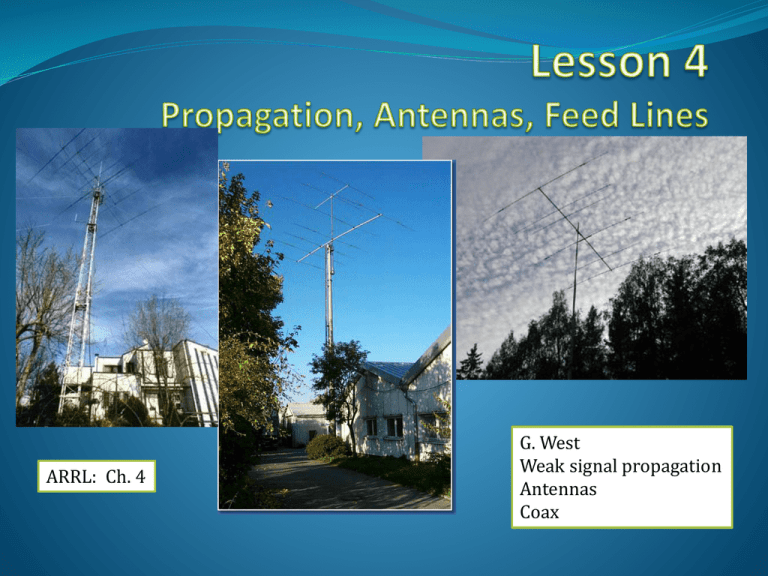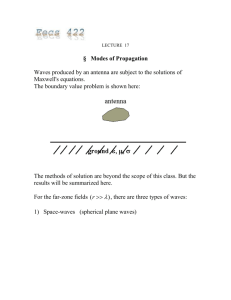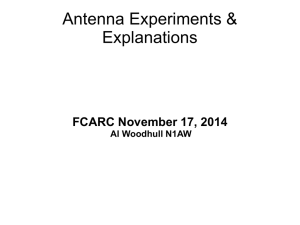Lesson 4 - Wednesday Training Net
advertisement

ARRL: Ch. 4 G. West Weak signal propagation Antennas Coax -ISS 414 mi 260 mi Ionosphere 30 mi. Weather The ionosphere is the part of the atmosphere that enables the propagation of radio signals around the world. Each reflection is called a hop. T3A11 30 to 260 miles Ionosphere and its layers 3 Radio waves is the usual name for electromagnetic waves that travel through space. T5C07 T3A07 6 • Electromagnetic radiation comprises both an Electric and a Magnetic Field. • The two fields are at right-angles to each other and the direction of propagation is at right-angles to both fields. • The Plane of the Electric Field defines the Polarization of the wave. X Y Magnetic Field, H Electric Field, E T9A02 The electric field of vertical antennas is perpendicular to the Earth. H & V Polarized Antennas T3A04 Polarization often becomes random as a radio wave travels through the ionosphere. 8 8 Very High Frequency 30 – 300 MHz Meaning Freq Range? FM Mode for repeaters 144 – 148 MHz 2 meter frequency range Ultra High Frequency 300 – 3000 MHz FM 70 cm frequency range 420 – 450 MHz 70 cm simplex calling frequency 446.000 MHz VHF UHF 30 MHz 300 MHz CHP 420 MHz 70 cm 450 Mhz FRS/GMRS 50 MHz 6 Meters 54 MHz TV 88 FM Broadcast 108 902 MHz 33 cm 928 MHz TV Aviation Aviation Cell Phone Military 144 MHz 2 Meters 1240 MHZ 23 cm 1300 MHz 148 MHz Municipal 219 MHz 1.25 Meters 225 MHz 300 MHz Technician class home range 6 meters the un-predictable band Line of sight communications Suited for repeater operation FM and digital modes. Suited for mobile and portable comm. 2 mtr SSB and CW at lower band edge Satellite and EME 3000 MHz Technician class home range Line of sight communications Suited for repeater operation 70 cm suited for mobile and portable Satellite and EME The distance at which radio signals between two points are effectively blocked by the curvature of the Earth, is the radio horizon. T3C10 VHF & UHF radio signals will generally travel “line of sight.” VHF & UHF radio signals are blocked by the curvature of the Earth. VHF and UHF radio signals usually travel somewhat farther than the visual line of sight distance between two stations because the Earth seems less curved to radio waves than to light. T3C11 11 UHF signals are often more effective from inside buildings than VHF signals as the shorter wavelength allows them to more easily penetrate the structure of buildings. T3A02 UHF signals are short enough in wavelength to permit bouncing around inside buildings and penetrating of walls. When using a directional antenna, your station might be able to access a distant repeater if buildings or obstructions are blocking the direct line of sight path by finding a path that reflects signals to the repeater. T3A05 Directional Antenna can be used to bounce signal to reach repeater blocked by building 13 Should another operator reports that your stations 2 meter signals were strong just a moment ago, but now they are weak or distorted, try moving a few feet, as random reflections may be causing multi-path distortion. T3A01 Rapid fluttering from multipath while moving is called picket-fencing T3A06 Error rates are likely to increase on VHF or UHF data signals propagated over multiple paths. T3A10 Temperature inversions in the atmosphere causes "tropospheric ducting". T3C08 Tropospheric Ducting 15 Tropospheric scatter is responsible for allowing over-thehorizon VHF and UHF communications to ranges of approximately 300 miles on a regular basis. T3C06 Tropospheric 16 The term "knife-edge" propagation refers to signals that are partially refracted around solid objects exhibiting sharp edges. T3C05 17 When VHF signals are being received from long distances these signals are being refracted from a sporadic E layer. T3C02 Sporadic-E refractions off ionized patches of the ionospheric E-layer are common in summer on 6-meters. Sporadic E propagation is most commonly associated with occasional strong over-the-horizon signals on the 10, 6, and 2 meter bands. VHF band. T3C04 Sporadic E DL2YMR Sporadic E 10 meters 2010 The 6 meter band is best suited to communicating via meteor scatter. T3C07 Leonids and Geminids meteor showers provide these conditions A characteristic of VHF signals received via auroral reflection is that the signals exhibit rapid fluctuations of strength and often sound distorted. T3C03 Incoming signals from a distant station heard hundreds of miles away will sound fluttery and distorted by auroral bounce 22 Meaning Freq Range? High Frequency 3 – 30 MHz Most common Voice Mode SSB SSB Bandwidth 3 kHz HF 3 MHz 3.5 MHz 80 Meters 4 MHz 5.33 MHz 60 Meters 5.4035 MHz 7 MHz 40 Meters 7.3 MHz 10.1 MHz 30 Meters 10.150 MHz 14 MHz 20 Meters 14.350 MHz Lower sideband Upper sideband During daylight hours is generally the best time for long-distance 10 meter band propagation via the F layer. 17 Meters T3C09 15 Meters 12 Meters CB 28 MHz 10 Meters 29.7 MHz 30 MHz Primary General and Extra Class privledges Limited Technician privileges SSB on 10 M CW on 40 and 15 meters Long distance communications Large antennas. Day to night from upper to lower freq. 60 and 30 meter special restrictions Solar activity critical The ionosphere is the part of the atmosphere that enables the propagation of radio signals around the world. Each reflection is called a hop. T3A11 30 to 260 miles Ionosphere and its layers 25 T3A09 “Skip” signals from the ionosphere become elliptically polarized. Skip happens when signals refract and reflect off the ionosphere. DX stations 1000 miles away come booming in. Every 30 seconds signal goes from strong to weak and back. Caused by random, ever changing polarization of the original signal. Either vertical or horizontal polarized antennas can be used. 26 26 Ionosphere from space Ionosphere ISS Image Solar radiation Charged ionosphere Uncharged ionosphere http://dx.qsl.net/propagation/ Coronal Mass Ejections (CME) Sun Spot activity - approximate 11 year cycle Solar Flux, (Index) SFI : is a measure of the radio energy emitted from the sun. Values 50 to 300. //the higher the better K index, disturbances in the horizontal component of earths magnetic field. Values 0 to 9 A index, related to K in an averaging, values 0 t0 400 Solar Flux Index (SFI) - Higher numbers mean better propagation. Lower A index means better propagation. Highs for Cycle 24 Flux: 190 - 24 Sep 2011 Sunspots: 208 - 9 Nov 2011 Summary for the past 24 hours: K-Index - Falling numbers mean improving conditions and better propagation Space weather for the past 24 hours has been strong. Radio blackouts reaching the R3 level occurred. Space weather for the next 24 hours is predicted to be minor. Radio blackouts reaching the R1 level are likely. A simple dipole mounted so the conductor is parallel to the Earth's surface is a horizontally polarized antenna. T9A03 Simple Dipole Three element beam 33 33 The approximate length of a 6 meter 1/2-wavelength wire dipole antenna in inches is ? T9A09 112 inches 6 meters / 2 = 3 m (1 meter ≅ < 40 inches) 40 inches X 3 = < 120 inches Six Meter ½ Wavelength Dipole The strongest radiation from a half-wave dipole antenna in free space is broadside to the antenna. T9A10 34 34 The approximate length of a quarter-wavelength vertical antenna for 146 MHz in inches is? T9A08, T9A09 2 meters /4 = ½ meter (1 meter ≅ < 40 inches) 19” Radiation Pattern of an Antenna Changes as Height Above Ground is Varied 35 35 (Keep it simple silly) The approximate length of a 6 meter 1/2-wavelength wire dipole antenna is ? In inches ________ a. b. c. d. 6 50 112 236 The approximate length of a quarterwavelength vertical antenna for 146 MHz is? In inches _______ a. b. c. d. 112 50 19 12 1 meter ≈ 40 in. T9A04 The typical “rubber duck antenna Does not receive or transmit as well as a full size ground-plane antenna T9A07 When transmitting from inside of a vehicle your signal may be as much as 10 to 20 times weaker than from an outside mobile antenna. Rubber duck dB = 10 log (p0wer ratio) Just remember that for every double, or half change in power, there is a 3 dB change. Increase or decrease depending on the direction of change. (I rely on my finger calculator.) Example 1. What is the approximate amount of change in dB of a power increase from 5 watts to 10 watts? 3 db Example 2. What is the approximate amount of change in dB, from a power decrease from 12 watts to 3 watts? 6 dB Example 3. What is the approximate amount of change in dB, of a power increase from 20 watts to 200 watts? 10 dB T9A01 A Beam Antenna, or Yagi, is an antenna that directs the signal in one direction. T3A03 Horizontal directional antennas are Normally used for weak signal CW and SSB on VHF and UHF At the higher UHF frequencies, dish antennas are commonly used. The gain of an antenna is the increase in signal strength in a specified direction when compared to a reference antenna. Measured in dB T9A11 Isotropic Radiator Pattern “Gain” of an antenna dBi = gain reference to an isotropic antenna dBd = gain reference to a dipole antenna 40 40 Azimuth pattern T9A01 A beam antenna concentrates signals in one direction A Beam Antenna – The Yagi Antenna 43 43 It is important to have a low SWR in an antenna system that uses coaxial cable feedline to provide efficient transfer of power and reduce losses. T9B01 50 ohms is the impedance of the most commonly used coaxial cable in typical amateur radio installations. T9B02 Coaxial cable is used more often than any other feedline for amateur radio antenna systems because it is easy to use and requires few special installation considerations. T9B03 Copper Wire Outside Insulation Mesh Insulation 45 45 Electrical differences exists between the smaller RG-58 and larger RG-8 coaxial cables in that RG-8 cable has less loss at a given frequency. T9B10 Coax Cable Type, Size, and Loss per 100 feet Coax Type RG-58U RG-8X RG-8U RG-213 Hardline T9B11 Size Small Medium Large Large Large, Rigid @ 100 MHz @ 400 MHz 4.3 dB 3.7 dB 1.9 dB 1.9 dB 0.5 dB 9.4 dB 8.0 dB 4.1 dB 4.5 dB 1.5 dB The lowest loss feedline at VHF and UHF is an Air-insulated hard line.. 46 46 SWR is determined by the proportions of forward and reflected power. T7C03 In practice it is a measure of how well antenna and feed line impedances are matched. If there is no reflected power, there is no SWR. SWR = 1:1 T7C04 SWR of 1:1 is a perfect match. T7C06 SWR greater that 1:1 shows a degree of mismatch. T7C05 SWR greater than 2:1 may cause the transmitter’s protective circuits to reduce output power. Antennas that are too short or too long. Faulty feedline or connectors. T9B09 Erratic SWR sometimes indicates a loose connector. SWR = √PF + √PR √PF - √PR PF is the forward RF power PR is the reflected RF power Correct any physical problems An antenna tuner matches the antenna system impedance to the transceiver's output impedance. T9B04 MFJ-971 Portable QRP 200 Watt Tuner Palstar 1500 Watt Auto-Tuner Icom 7000 with LDG 7000 Auto-Tuner Miracle QPak 50 Watt Manual Tuner MFJ-994B 1500 Watt Auto-Tuner 49 49 As the frequency of a signal passing through coaxial cable is increased the loss increases. T9B05 The Higher the frequency the more the loss A Type N connector is most suitable for frequencies above 400 MHz? T9B06 PL-259 type coax connectors are commonly used at HF frequencies. T9B07 BNC, Type N, and PL 259 Connectors 50 50 N Male N Female Male VHF PL-259 Male BNC Male SMA Female SMA Female BNC Female SO-239 Understand the type of connector on your radio You may need an adapter from your coax connector to your radio Never buy cheap coax, connectors, or adapters 43 Coax connectors exposed to the weather should be sealed against water intrusion to prevent an increase in feedline loss. T9B08 A loose connection in an antenna or a feedline might cause erratic changes in SWR readings. T9B09 Don’t kink, crush, twist, crimp, mangle, contort, distort or otherwise fubar your coax. Make sure all coax connections are tight to help minimize interference 52 52 Study flash cards www.hamexam.org Radio Fundamentals Lesson 1 • T1B • T3B • T8A Rules & Regs. Lesson 2 • T1A • T1C • TID • T1E • T1F Comm. w/ Others Antennas Propagation Equipment Electricity Safety Lesson 3 • T2A • T2B • T2C • T8B • T8C Lesson 4 • T3A • T3C • T9A • T9B • T7C Lesson 5 • T4A • T4B • T7A • T7B • T8D Lesson 6 • T5A • T5B • T5C • T5D • T6A • T6B • T6C • T6D • T7D Lesson 7 • T0A • T0B • T0C






